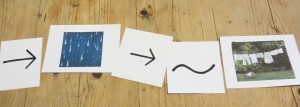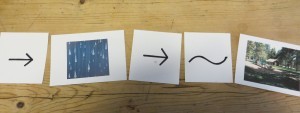 Rather than repeat the background information, if you have hit on this post for the first time, we suggest that you look at the ‘FP/KS1 Introducing Algorithms: ‘IF’ and ‘THEN‘ first, which will explain where we are coming from.
Rather than repeat the background information, if you have hit on this post for the first time, we suggest that you look at the ‘FP/KS1 Introducing Algorithms: ‘IF’ and ‘THEN‘ first, which will explain where we are coming from.
Aim: This activity introduces the idea of ‘not’ – as in the syntax “If this, then NOT this.”
Activity: We used the ’tilda’ symbol for ‘not’. Some people will use the logic symbol that looks like a rotated ‘L’ for ‘not’ but we rejected that as it is way too complicated to find on a keyboard and at some point, children will progress from picture coding to digital coding so the transition will be easier.
Construct a ‘sentence’ yourself using the syntax “if this…then NOT this”. Say it aloud as you put the symbols and pictures down on the table. Then repeat but asking for suggestions to complete the ‘sentence’ e.g IF sun, then NOT raincoat/ NOT umbrella / NOT boots etc.
Then encourage children to swap the different picture cards to see which ones make sense and which ones do not. If the sentence is not logical, the children know this but seem to like it because they think it’s funny – maybe it appeals to their sense of the ridiculous. (If it’s raining, then we can hang all the clothes out and they’ll get all wet!!)
If the syntax was correct but the logic was ‘wrong’, we gave them a ‘bug’ fridge magnet.
The next step was to move the position of the tilda so that the ‘sentence’ (or line of code) reads
e.g If NOT ..raining THEN …we can hang the washing out
One of the more able children started to explore double negatives and was making sentences such as
If NOT… raining THEN NOT boots
Here are some of the lines of code that our 4 year olds constructed on their own:
We found that children did not want to change their original ‘story’ by adding a different ‘predicate’ (effect). It worked much better if they were allowed to create a brand new ‘story’.
Useful Resources




2 Comments on “FP/KS1 Introducing Algorithms 2: ‘NOT’”